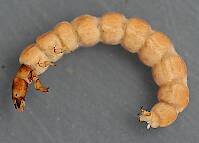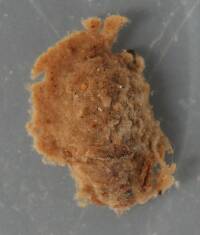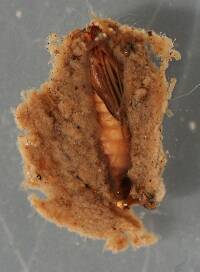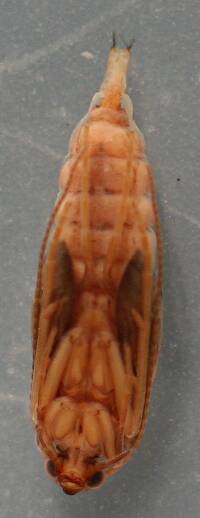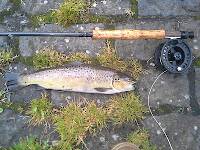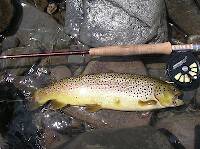
Hex Mayflies
Hexagenia limbata
The famous nocturnal Hex hatch of the Midwest (and a few other lucky locations) stirs to the surface mythically large brown trout that only touch streamers for the rest of the year.
Featured on the forum

This one was surprisingly straightforward to identify. The lack of a sclerite at the base of the lateral hump narrows the field quite a bit, and the other options followed fairly obvious characteristics to Clostoeca, which only has one species, Clostoeca disjuncta.

Troutnut is a project started in 2003 by salmonid ecologist Jason "Troutnut" Neuswanger to help anglers and
fly tyers unabashedly embrace the entomological side of the sport. Learn more about Troutnut or
support the project for an enhanced experience here.
Chris_3g
Posts: 59
Posts: 59
Chris_3g on Jul 7, 2008July 7th, 2008, 3:06 am EDT
So, I was fishing a small creek this weekend, which I know well, and deeply appreciate, for its hard-fighting, but rather small rainbows, and I came to a spot which produced a larger-than-average rainbow during my last trip. It's basically a small 90-degree bend pool with a fast run dumping in and a slow pool downstream. There is a large rock in the center: the water flows fast around the back side of the rock, and the water upstream of the rock (where the fast-flowing run dumps in) has a bit of depth to it. I find it best to swing a fly from the fast water flowing around the rock into the slower water just upstream of the rock.
Anyway, after my go-to fly produced a few hits, I switched to a #6 cone-head olive woolly bugger. The first drift through, I let the fly hang / sink in the pool and WHACK! The water is rather turbid, so I was pretty sure that I saw a trout returning to his initial lie. So, I swung again and WHACK! Again, I saw the same trout returning to the same lie, so I thought I might as well give it another shot, though I expected that my chances were slim to none. Then, WHACK and he was on the line! After a nice fight, a bit of admiration, and a photograph, I released him to swim another day. If he's kind enough to oblige, I'm hoping to come back in the fall for another shot.
Anyway, this was the first time I had actually felt / seen a trout aggressively snap at a fly just for being there. Obviously, I was invading his space, and he didn't like it. It was definitely a nice lesson for me that the bigger fish have comfort zones that they don't want invading either.
Here's a link to the picture: Angry Rainbow
Chris.
Anyway, after my go-to fly produced a few hits, I switched to a #6 cone-head olive woolly bugger. The first drift through, I let the fly hang / sink in the pool and WHACK! The water is rather turbid, so I was pretty sure that I saw a trout returning to his initial lie. So, I swung again and WHACK! Again, I saw the same trout returning to the same lie, so I thought I might as well give it another shot, though I expected that my chances were slim to none. Then, WHACK and he was on the line! After a nice fight, a bit of admiration, and a photograph, I released him to swim another day. If he's kind enough to oblige, I'm hoping to come back in the fall for another shot.
Anyway, this was the first time I had actually felt / seen a trout aggressively snap at a fly just for being there. Obviously, I was invading his space, and he didn't like it. It was definitely a nice lesson for me that the bigger fish have comfort zones that they don't want invading either.
Here's a link to the picture: Angry Rainbow
Chris.
CaseyP on Jul 7, 2008July 7th, 2008, 3:44 am EDT
a chance sunbeam showed me a brown in a small pool--i could see every move. i cast the biggish drowned ant into his range, and he did just as you said: smacked it with the side of his head. he did this three times, and then finally bit. i wasn't sure what i'd seen, but you have described it perfectly.
"You can observe a lot by watching." Yogi Berra
Magillaonfi
Posts: 1
Posts: 1
Magillaonfi on Jul 9, 2008July 9th, 2008, 11:32 am EDT
More likely it was a bit near/farsighted on that side. Members on our staff have run into this situation more than once resulting in a number of "false strikes" with repeated after strikes.
Billy Boy
GONZO on Jul 9, 2008July 9th, 2008, 3:37 pm EDT
Chris,
Although I'm not sure what was going on with Casey's brown, the reaction you described is really quite common when fishing large streamers. Usually, the repeated attacks appear to be a territorial rather than a feeding response to the large fly. Sometimes the fish seems to tire of the repeated intrusions and clamps down decisively, but at other times they will continue to hit the fly without ever being hooked. That can be very frustrating. Some suggest that "stinger" hooks help, but my feeling is that they mostly just increase the chances of snagging territorial fish.
The reactions that Casey and Magillaonfi describe remind me more of what I see most often with naive little brookies or wise old browns. I once had a little brookie hit the same fly thirteen times before being hooked, and some educated browns will bunt a fly with a closed mouth or nip parts of the fly. My best guess is that the bunters are trying to see if the fly moves and the nippers are trying to taste their meal before eating it. As for the little brookies, I think they are just hungry and misjudge what it takes to down a buoyant dry.
By the way, that's a beautiful rainbow.
Although I'm not sure what was going on with Casey's brown, the reaction you described is really quite common when fishing large streamers. Usually, the repeated attacks appear to be a territorial rather than a feeding response to the large fly. Sometimes the fish seems to tire of the repeated intrusions and clamps down decisively, but at other times they will continue to hit the fly without ever being hooked. That can be very frustrating. Some suggest that "stinger" hooks help, but my feeling is that they mostly just increase the chances of snagging territorial fish.
The reactions that Casey and Magillaonfi describe remind me more of what I see most often with naive little brookies or wise old browns. I once had a little brookie hit the same fly thirteen times before being hooked, and some educated browns will bunt a fly with a closed mouth or nip parts of the fly. My best guess is that the bunters are trying to see if the fly moves and the nippers are trying to taste their meal before eating it. As for the little brookies, I think they are just hungry and misjudge what it takes to down a buoyant dry.
By the way, that's a beautiful rainbow.
Quick Reply
Related Discussions
Topic
Replies
Last Reply
5
Jul 15, 2012
by Jmd123
by Jmd123



